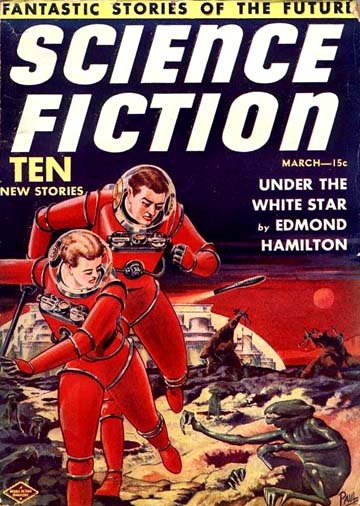
That title – Science Fiction (Stories) was used for the first time by a magazine in 1939, with the introduction of the March 1939 issue of Science Fiction.
Cover, naturally, by Frank R. Paul.
As early pulp covers for SF rags go, it’s not the greatest. On the other hand, Edmond Hamilton’s name featured on there was a name to conjure with, at least in early fan circles.
Interestingly, this magazine, bearing the genre’s name, is also tied, at least historically, to Hugo Gernsback.
The magazine was originally edited by Charles D. Hornig, the seventeen-year-old fan that Hugo Gernsback had hired to edit Wonder Stories (Hornig’s greatest claim to influence while editing that magazine was the purchase and publication of Weinbaum’s A Martian Odyssey), where he would remain as editor until that magazine was sold. He then moved on to edit Science Fiction, Future Fiction and Science Fiction Quarterly, starting in 1939 and working on them through 1943, after which Robert A.W. Lowndes took the helm.
As is noted on the Galactic Central website, this particular title has one of the more complicated publishing histories, making it an interesting title to try and collect.
I’ve almost, but not quite, managed to obtain all of the issues that qualify as “Volume 1 Number 1” issues because under the definitions and criteria I use for such things, a V1N1 can also be a major title change, a resumption of publication following a hiatus or the re-introduction of a title by new publishers. “Science Fiction” has actually gone through all of those changes.
The first issue hit the stands in March of 1939, just a few months prior to the first Worldcon. Hornig is known to have attended, so it is more than likely that attendees were able to pick up an issue or two (not to mention being button-holed for rates and acceptances.)
The magazine was quickly followed by a companion – Future Fiction – in November of the same year, and a few months after that by stablemate Science Fiction Quarterly.

Science Fiction limped along for close to three years with a spotty publishing schedule, producing five issues in 1939, three issues in 1940 and four in 1941.
It was then merged with its former companion, Future Fiction, becoming Future Combined with Science Fiction Stories.

(One wonders if regular readers, finding these magazines on the newsstands, said to themselves “Oh, THAT’S what happened to Science Fiction!”. Fans themselves would most likely have been well-informed of the title change from reporting in the fanzines.)
Future combined with didn’t last long under that incarnation either. It produced 11 issues over the span of the next three years (1941 – 1943) and then it disappeared from the stands.
During that span it also changed titles two more times: In October of 1942 it was re-titled as Future Fantasy and Science Fiction and in April of 1943 that title changed once again to Science Fiction Stories.

The magazine(s) then lay dormant until the 1950s’ explosion of SF publications, appearing once again under the name of Future Combined with Science Fiction Stories (May/June 1950).

That publication then changed titles to Future Science Fiction Stories (January 1952) and then again a few months later to Future Science Fiction* (May 1952). Little things like the addition of “Stories” to a magazine title are a “big thing” for collectors like me.)

Meanwhile, elsewhere in the Science Fiction universe, two test titles for a quasi-revival of Science Fiction took place, one issued in 1953 and one in 1954. This was also an experiment in changing to a digest format and Future itself followed suit. However, shortly thereafter it was also determined that “Science Fiction” was the stronger of the two titles, so Future Science Fiction Stories was discontinued in favor of Science Fiction Stories (with volume numbering continuing from Future).

That title (Science Fiction Stories) was introduced in January of 1955.

The changes weren’t done yet though. Five months after the introduction of Science Fiction Stories, the title was once again altered, this time to The Original Science Fiction Stories, (a marketing attempt to distinguish and highlight its history on the stands). It would then continue publication until 1960, publishing 32 more issues.

I have to admit that the “Original” in the title did capture my attention when I discovered the magazine in a used book store.
Science Fiction Quarterly has its own short history of V1N1s, beginning in the Summer of 1940, it ran until 1943. When Science Fiction and Future Fiction were mostly finished with their machinations, Quarterly was revived five years later, with the May, 1951 issue.

As you can see, collecting pulp magazines is not as easy as it might otherwise appear, not even if you are only after the “first” issue of a particular title.
The images used here are sources from “Galactic Central” website – philsp.com, and are not part of this author’s collection. Below, scans of the issues in the author’s collection (I’ve not quite managed to obtain all of the “Volume 1, Number 1” issues, currently holding 9 of the 13 individual volumes. And that is not counting the foreign editions of the magazines, of which there were several in the UK and Canada.)
*Not to be confused with Alex Schvartsman’s more recent and unrelated magazine Future Science Fiction Digest



















